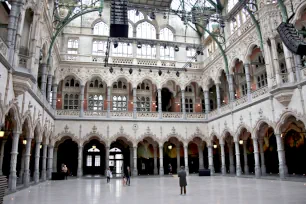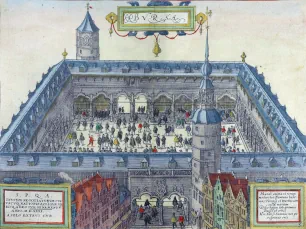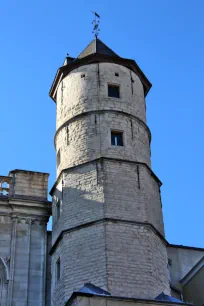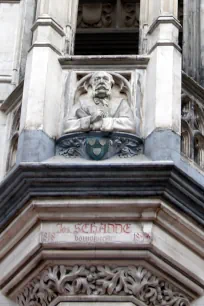The Handelsbeurs is a historic stock exchange building that is often called ‘the Mother of all Stock Exchanges’ since it provided the blueprint for many other stock exchange buildings across Europe. The current building is a reconstruction from the 19th century. The original structure from the 16th century was destroyed by a fire.


By the early 16th century, Antwerp had become a burgeoning trade center thanks to its growing port. Merchants required a location where they could meet with brokers and moneylenders. At first they met in the courtyard of a patrician house, now known as the ‘Oude Beurs’.
The Mother of all Stock Exchanges
But as Antwerp became the main trading center of the Low Countries, the old stock exchange building soon proved too small. So in 1532 a new, much larger, building opened in the commercial center of the city. This building, now known as the ‘Handelsbeurs’ would later become the inspiration for stock exchanges in other cities such as London (1565) and Amsterdam (1611). The latter took up the mantle of Antwerp as the region’s leading trade center after the fall of Antwerp in 1584-1585.



The building was designed by famed Flemish architect Domien de Waghemakere, who had just completed the tower of the Antwerp Cathedral. He designed a structure in Brabantian Late Gothic style with a central open courtyard flanked by arcades with net vaulting. The building covered the middle of four city blocks, which meant that four streets on all sides converged on the building.
Disaster strikes (twice)
In 1581 the Handelsbeurs burned down but a new building rose quickly from its ashes, following the same floor plan and design. After Spanish troops invaded the city in 1584, commerce grinded to an almost complete stop and the building lost its original function. It was only in the 19th century that it was used as an exchange again.
By now, exchange buildings tended to be covered buildings, hence the then very controversial plan to modify the historic building and cover the open courtyard with a roof, which was added in 1853 by the engineer Charles Marcellis. He created a spectacular iron-and-glass dome, based on construction techniques taken from the famous Crystal Palace in London, a magnificent building that had hosted the Great Exhibition the year before.
Just five years later disaster struck again and the Handelsbeurs burned down once again. This time just a single tower (which you can still see from the Borzestraat) escaped destruction.
The current building
The building we see today dates from 1869-1872 and is a Neo-Gothic reinterpretation of the original structure. It follows the original floor plan but was constructed with more modern techniques such as an iron frame. The building was designed by Jozef Schadde, who was honored in 1896 with a bust that decorates the oriel of the upper arcade. Schadde stayed true to the original High Gothic design of the arcades. He opened up the second floor and covered the 40×51-meter-large courtyard (131x167ft) with an iron-and-glass construction that allows plenty of natural light to enter the courtyard. The beautiful wooden floor is unfortunately lost and was replaced by a bland white stone floor that would be more suited for a kitchen, which takes away a lot of the courtyard’s former charm. The 243 coats of arms that adorned the ceiling since the late 1870s are also missing. There are however a number of coats of arms visible on the iron roof structure.
The Handelsbeurs today

In 1997 the stock exchange moved to Brussels and the historic building stood empty for years. By the time negotiations about a possible renovation started, the building had already fallen into a severe state of disrepair. It finally reopened in 2019 as part of an upscale hotel that is housed in the adjacent complex that includes the Schippersbeurs (a charter exchange from 1895) and an elegant Beaux-Arts building that was formerly the headquarters of Banque d’Anvers, a local bank.
Today the Handelsbeurs is used as an event space but it is open to visitors during weekends and holidays from 10-18 unless an event is planned during that time. Entrances are at Borzestraat and Twaalfmaandenstraat. The latter is entered from the Meir shopping street.

